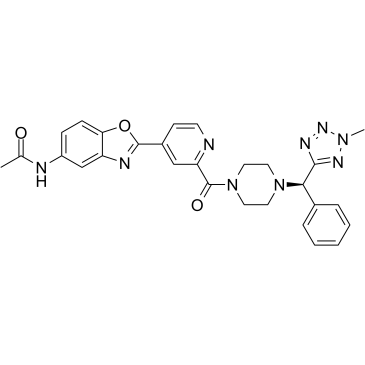| Description |
JNJ4796 is an oral active fusion inhibitor of influenza virus, neutralizing influenza A group 1 viruses by inhibiting hemagglutinin (HA)-mediated fusion. JNJ4796 mimics the functionality of the broadly neutralizing antibodies (bnAbs)[1].
|
| Related Catalog |
|
| Target |
EC50: 12 nM (H1/Bris), 66 nM (H1/Cal), 38 nM (H1/NCa), 22 nM (H1/PR8), 13 nM (H1/SI06), 449 nM (H5/H97), 3.24 μM (H5/Viet)[1]. Hemagglutinin[1].
|
| In Vitro |
Like bnAb CR6261, the mechanism of action of JNJ4796 is demonstrated to be based on inhibition of the pH-sensitive conformational change of HA that triggers fusion of the viral and endosomal membranes and release of the viral genome into the host cell[1].
|
| In Vivo |
Oral administration of JNJ4796 protects mice from lethal challenge of 25 times the median lethal dose (LD50) of H1N1 A/Puerto Rico/8/1934 virus. Doses of 50 and 10 mg/kg of JNJ4796 twice daily, initiated one day before challenge and continuing for 7 days, results in 100% survival at day 21 in comparison to the less potent compound JNJ8897 for which less than 50% survival is achieved[1]. Oral doses of JNJ4796 results in dose-dependent efficacy after a sublethal viral challenge (LD90), with twice daily administration of 15 and 5 mg/kg of JNJ4796 giving rise to 100% survival[1]. Animal Model: Female BALB/cAnNCrl mice intranasally infected with 2 × 25 μL of 25 × LD50 or 1 × LD90 of H1N1 A/Puerto Rico/8/34 dissolved in sterile phosphate buffered saline (D-PBS)[1] Dosage: 50 and 10 mg/kg. Administration: Oral twice daily for 7 days. Result: Resulted in 100% survival at day 21 in comparison to the less potent compound JNJ8897.
|
| References |
[1]. van Dongen MJP, et al. A small-molecule fusion inhibitor of influenza virus is orally active in mice. Science. 2019 Mar 8;363(6431).
|
